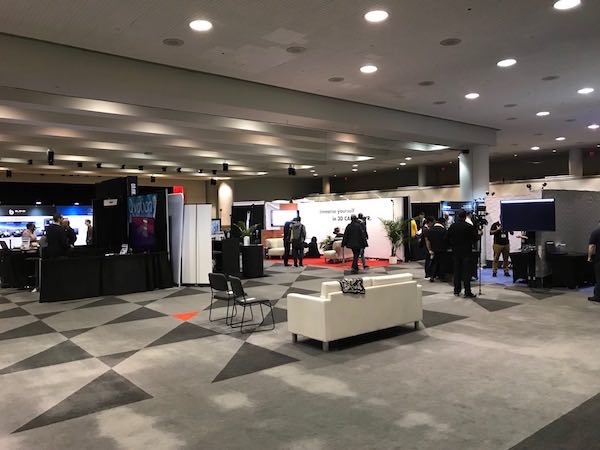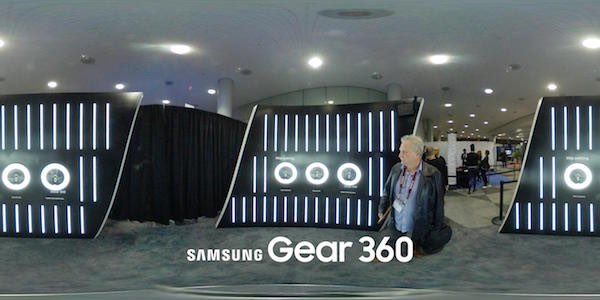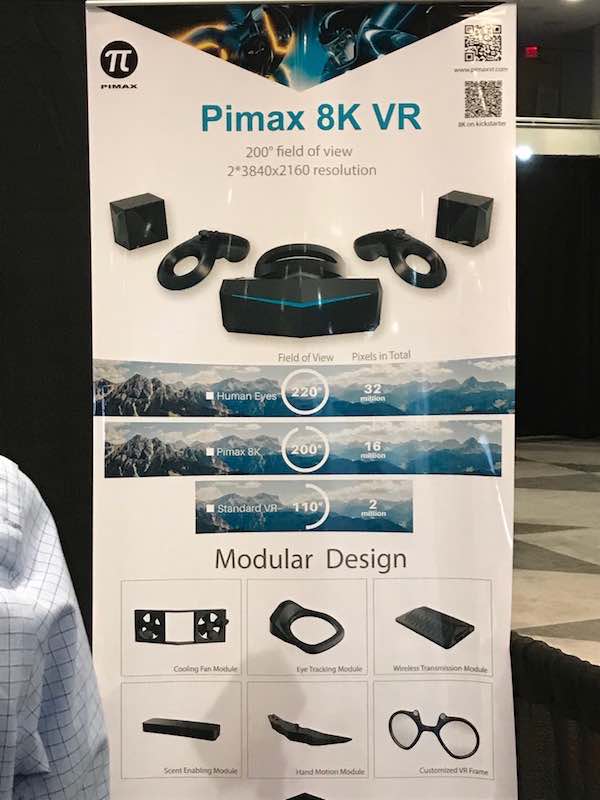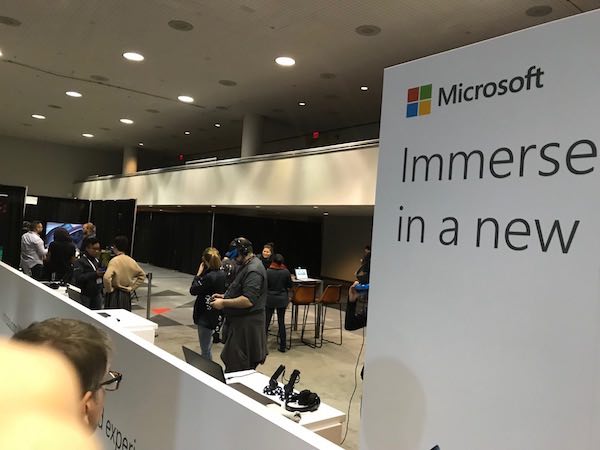The NYVR Expo is a new conference taking place together with the NY PhotoPlus Exhibition and conference. As can be expected, the NYVR was just a side show for the NY PhotoPlus event. While the PhotoPlus 2017 expo was full of people roaming the aisles, the NYVR Expo 2017 was quite a different event. There was much less interest in this event and many of the attendees were from the VR space, with the rest driven to the show floor by some general interest or trying to find out what this VR is all about.
Of course the expo was mostly about VR if we include MR as the Microsoft designation for ‘Mixed Reality’. After asking a lot of people to explain to me the difference, I am still searching for an explanation that is logical and creates a clear distinction between VR and MR*. What Microsoft was showing on their booth did not differ that much from HTC calling their experience VR. So far I am sticking with my view that MR is more about a marketing perspective than actually technological differences.
 NYVR Expo 2017
NYVR Expo 2017
With 47 exhibitors the show floor was allowing for wide aisles and plenty of room for the spectators to try out the latest in VR that the companies brought to NY. Considering the size of the VR industry today, 47 does not sound too bad, but we have to take into account that almost half of the spaces were filled with start ups (21 in total) in the Incubator zone. The incubator zone was sponsored by the NY Media Lab and created a platform for a wide range of developmental ideas to be shown to the attendees. These were mostly pre-startup status looking for some angel investor to enable them to bring their ideas to the next level.
 NYVR Expo Show Floor
NYVR Expo Show Floor
The rest of the show floor was divided between VR / MR hardware, 360º video cameras and app developers. With one exception. hardware development was absent from the show floor with more of a focus on creating consumer interest through letting the attendees try out the respective headsets. This created a very unique situation where even though the aisles were not overfilled the waiting time for trying out a headset could easily exceed 30 minutes. A very unusual situation for an exhibition.
This goes back to a unique characteristic of VR / MR. It is a one on one experience, meaning one person can try out one headset and the interaction time cannot be shared with other attendees. While some of the companies had monitors showing what the users were experiencing, it was more of a feedback to the booth attendants helping the users through the various issues with using the systems.
In a certain way, using VR reminds me of the introduction of the Nintendo Wii. In most cases it involved some level of physical activity dependent of the nature of the respective experience and attaching the display monitor to the forehead of the user. In the current status, this actually decreases the range of movement compared to a Nintendo Wii, as the headset is tethered to the PC and the interaction space is limited to about 10’x10′ (3x3m). Stepping into this space is at your own risk.
Incubator Zone
This area was interesting, but far away from demonstration of products even as beta designs. It was about ideas that needed to find a home to be developed into real consumer products. While the respective developers may not like to hear that, it is true for most participants in this area. I think it is a great format for some very early demonstrations of products that may, or may never, reach the consumer.
The topics reached from children books to a brain wave interface. As you can see there was a wide range of topics covered with a table top. In general, there was a Oculus Rift headset attached to an open computer case for proper cooling. This describes most of the presentations.
360 Degree Video
Several companies showed their 360º video cameras as an acquisition tool for VR / MR headsets. Not all these cameras were shown on the NYVR Expo show floor, some were also shown in the main exhibition space of the NY PhotoPlus Expo. On the show floor you could see consumer versions of 360º cameras from Ricoh, Kodak and Samsung. Samsung had a little setup taking a picture in a round space with maybe 10′ (3m) diameter and sending it to you via email. You can see the result below.
 NYVR Samsung Gear 360 The image shows some of the shortcomings of these extreme lenses. I do have legs and do not float through midair. It is also difficult to get a sense of the actual setup from the image. Imagine a round space with a column in the middle where the camera is mounted. The shelves with the vertical lights are actually two round shelves, as the left side of the image connects with the right side. Viewing the image with a VR headset will put you right in the middle of the scene where the camera is placed. This is the same as with every other camera.
NYVR Samsung Gear 360 The image shows some of the shortcomings of these extreme lenses. I do have legs and do not float through midair. It is also difficult to get a sense of the actual setup from the image. Imagine a round space with a column in the middle where the camera is mounted. The shelves with the vertical lights are actually two round shelves, as the left side of the image connects with the right side. Viewing the image with a VR headset will put you right in the middle of the scene where the camera is placed. This is the same as with every other camera.
App Developers
The software and content aspect had a wide range of companies present. They reached from game app developers to B2B developers. The various companies were at different levels from early development to first sales status.
- Symmetrical demonstrated a game platform for consumer as well as Arcade platforms. The platform will work with any hardware, but the demonstrated solution was based on the HTC Vive. For arcades, the solution is to use a backpack approach to avoid tethering issues.
- Ovation was showing a sales ready implementation based on a Oculus Rift headset. The app allows the user to give a speech in front of a virtual audience with location ranging from meeting rooms to larger venues. This public speaking trainer is aimed at universities and enterprises as a tool to test and improve on essential presentations. The virtual room has an audience that responds somewhat to the given speech. In addition the app records the performance and gives feedback on significant aspects of the speech. These include speech patterns, word count, use of filler words and other aspects of giving a speech. All in all, the tool offered a very specific solution to potential users.
- Aquinas was offering a similar solution as a management training app. While it offers also a presentation training tool, it goes beyond that and works within the company’s management training suite. The uniqueness of this solution was that it was a VR solution developed by an existing company that has offered these training tools for a long period in time and using VR as an expansion of its existing offering.
- InstaLOD is not developing any VR solutions themselves, instead they are offering a tool to reduce the polygon count in VR content to reduce the load on GPUs. They are being used by car companies, for example, to make marketing content available in good quality for various platforms without redeveloping the content. This saves time and makes VR content available to platforms with varying computing power.
- The Glimpse Group demonstrated a variety of early stage VR apps targeting the B2B space. The applications reached from healthcare to financial tools and data visualization platforms. While most apps are not ready for entering the market quite yet they bring new aspects to the VR market. The most interesting aspect of the Glimpse Group is actually its business model. The group is a financing company that buys early stage VR companies and takes the original developers on as salaried employees. The company takes full ownership of the app for giving the original owner a stake in the total company. In addition they provide space, management, legal, fund raising and other functions. When the app becomes successful they will sell the entity (direct buyer or public offering) and take a percentage of the proceeds as their return of the initial investment. For many developers this has some interesting aspects especially related to fund raising and receiving a salary.
Hardware Developers
Besides the larger companies, there was one developer of VR hardware with a really new approach. While the larger companies were showing off their existing hardware in the market today, Pimax showed a unique prototype that one would expect at a silicon valley R&D conference. In general, all the hardware developers demonstrated a small space with a PC and a VR headset for visitors to try the respective hardware solution. It allowed visitors to test different hardware sets within a short period of time, making a good platform for comparative testing. Of course the content was different in each case making a direct comparison a little more difficult.
- Samsung had the weakest VR presentation by splitting their space between the 360º video camera and the Samsung Gear VR. In general there was very little new with this solution and it still showed the well known screen door effect, which is one of my strongest critique points with current hardware solutions.
- Oculus was not directly present, but their hardware set was available at various app developers, showing the same results as before. Even the newest Oculus Rift headset has a very noticeable screen door effect but is significantly better than the Samsung Gear VR.
- HTC showed the current Vive headset with an optical performance above the Oculus Rift but still with noticeable screen door effect. The images were fluid and the response of the VR environment was very fast and smooth. All in all, it was not bad but still at the same level as the first release. I noticed a weird optical effect in certain areas of the field of view and I am not sure if that was a fault of a less than perfect headset or if this is a software glitch in the demonstration software. I discussed this with the HTC personnel, but they had not even noticed anything unusual with the present headsets.
- Pimax demonstrated an 8K VR headset with a 200º field of view, which is coming close to the performance of our natural vision system. They are using two 3840 x 2160 displays side by side. The resulting headset makes you look more like a cylon from Battlestar Galactica than any other headset on the market.The sheer size is impressive as well as the resulting field of view. It makes you almost think you are entering the VR space instead of looking into the VR space through a window.
The optical performance was very good, with some screen door effect still noticeable. The displays are based on low persistence LCD displays, which seems to describe a fast switching display screen. They claiming frame rates of 150 – 180 fps but admit that they are basically refreshing only one display at a time. One could call this an ‘interlaced display’. Pimax calls this Brainwarp and claims that the user experiences 150 – 180 fps for the complete 8K system. Of course the shown content was based on a very slow moving squid through the ocean which did not allow us to verify this claim. They were also not disclosing who supplied the the LCD or any further details on the switching speed of the LC material. There was also noticeable color aberration in the imagery pointing the finger at a less than perfect lens solution.
 Pimax 8K VR Headset
Pimax 8K VR Headset
- The Microsoft booth was larger than the others allowing several visitors to test out headsets from different suppliers. Microsoft showed only headsets from other manufacturers based on their original designs. (No HoloLens here) I was able to try out the Acer headset that will be sold for $399. The people density in the booth was very low, which is typical for a VR presentation. I am glad I waited the 45 minutes to try out this latest development in VR hardware.
Before you were allowed to put on their headset, Microsoft made you sign a legal release form that they are not liable for any injury occurring during testing out the headset. Interestingly they were the only company at the show taking this step.
Overall, the Microsoft presentation was very smooth with some special interaction features to navigate the menus. The images were very smooth but on the soft side with a limited field of view. While the small field of view is dictated by the limited display resolution of 1440 x 1440 per eye they still manage to create a very smooth image. Together with the partially transparent content, the hardware showed the least screen door effect of all the headsets I tried out that day. T
he more important differentiator for the Microsoft design is the ‘inside out’ approach for the VR space mapping. There are no external sensors that have to be set up, it is all included in the headset itself. While the headsets are still tethered, this approach makes it easier for the consumer to turn on and enjoy VR in their home. Together with a reasonable price these headsets may make a good holiday present for the upcoming season. A very important test in the market for the whole VR industry.
 NYVR Expo – An unusual empty Microsoft booth
NYVR Expo – An unusual empty Microsoft booth
- VR Park is an arcade VR company demonstrating some arcade style installations including something resembling the good old 4K movies from the theme parks. Besides Microsoft they drew the largest crowd and longest waiting times for the eager attendees. From the age of the users it was clear that these were actual consumers that found their way down to the NY VR Expo.
 VRPark arcade style installations
VRPark arcade style installations
Analyst Comment
While the NYVR Expo was really a first attempt at a VR conference and expo, the drive from the attendees was limited at best. However, the nature of VR makes for limited access to the demonstrations even with very view people ahead of you. This maybe one of the key handicaps to the VR adoption in the market. Usage is limited to work or home and is a one on one experience. This is in contrast to the LCD TV, tablet and the smartphone that were the most successful technology introductions in the last few decades. These products allowed many users to view them in parallel (one device – many viewers) at shows or in retail. These devices were also part of a social status demonstration by the early adopters. For some reason I can’t fathom any early adopter running through the city with a VR headset (even if the tethering issue would be solved) on his head. Since this city is NY and craziness is part of living here, this says something.
On the other hand I was positively surprised by the Microsoft design headsets and the available software. It reminded me of the first Wii consoles as a complete new way of interacting with the computer. In general I see that the machine interface will play a more and more important role of the adoption of VR in the consumer’s home. With different suppliers all pushing their own controllers and different ways of using the controllers it makes for a steep learning curve especially for the more complex control structure in some games. It also makes it more difficult for users to switch from one platform to another, a side effect that may be actually appreciated and encouraged by the hardware developers.
Overall I have some increased hope for low cost hardware solutions as pushed by Microsoft as the quality is not worse by any means compared to more expensive headsets. As a matter of fact I would chose this solution over more expensive solutions based on the perceived the image quality. Keep in mind this is a very personal evaluation and will vary from person to person as well as with the content. (NH)
* I’ve heard the definition that VR takes you to another world, while AR or MR brings something extra to your world. It also sounds as though the Microsoft system headsets might be using some of the film that 3M showed at SID that is designed to reduce pixellation by optically smoothing the pixels (3M Shows New Solutions for Today’s Displays at Display Week) (BR)

